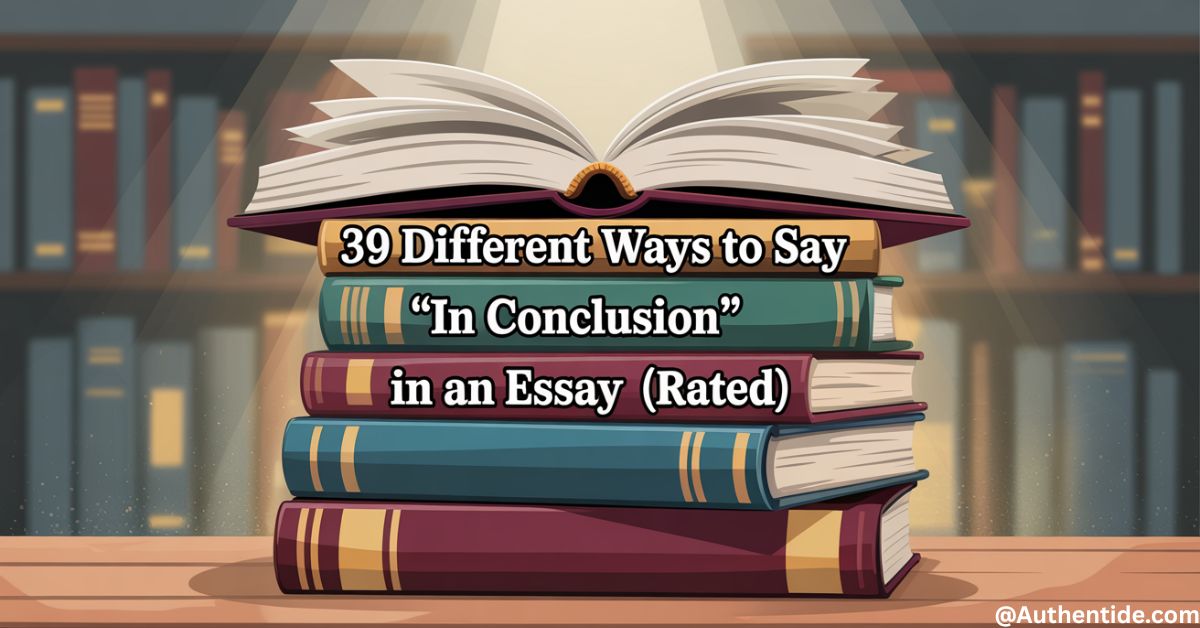In conclusion, examples often feel tired, but what if you could swap that phrase, catch your reader’s attention, and finish with flair? You surely don’t want your essay or email to end on autopilot. Starting strong with a fresh twist sets you up for a memorable closing.
I still remember sending an email to my colleague, Emma. I wrote, “In summary, here’s what we’ll tackle tomorrow.” It felt bland, even though the message mattered. A small phrase ruined the vibe. That taught me just how much weight endings carry (pun intended).
So here I present 39 alternatives to “in conclusion”, ranked and ready to sprinkle into your writing arsenal. You’ll find what to say instead of in conclusion, smarter ways to wrap up your argument, and in conclusion examples that don’t feel stale. Let’s dive in and make your final words count.
What to say instead of ‘In Conclusion’
- The weight of the evidence suggests…
- A thoughtful analysis would conclude…
- A balanced assessment of the above information…
- Across the board…
- Logically…
- After all is said and done…
- All in all…
- All things considered…
- As a final note…
- As already stated…
- At present, the best evidence suggests…
- At the core of the issue…
- Despite the shortcomings of…
- Finally…
- Gathering the above points together…
- Given the above information…
- In a nutshell…
- In closing…
- In essence…
- In review…
- In short…
- In sum…
- In summary…
- The above points illustrate…
- The evidence presented in this essay suggests that…
- This essay began by stating…
- This essay has argued…
- To close…
- To conclude…
- Last but not least…
- Overall…
- It cannot be conclusively stated that…
- It is apparent that…
- To make a long story short…
- To sum up…
- Ultimately…
- Undoubtedly…
- Weighing up the facts, this essay finds…
- With that said…
39 Ways to Say ‘In Conclusion’ (with Scenarios and Rates)
Here are 39 Ways to Say ‘In Conclusion’ :
1. The weight of the evidence suggests

Suggested use: Formal essays, academic summaries.
Scenario (Email to Professor Lee):
“The weight of the evidence suggests that the proposed method would reduce error rates significantly.”
2. A thoughtful analysis would conclude
Suggested use: Reflective reports, research proposals.
Scenario (Memo to Team Lead Sarah):
“A thoughtful analysis would conclude that our new strategy increases user engagement by 20%.”
3. A balanced assessment of the above information
Suggested use: Balanced, analytical tone.
Scenario (Email to Client Jordan):
“A balanced assessment of the above information indicates we should launch next quarter to capitalize on market trends.”
4. Across the board
Suggested use: Business summary, informal reports.
Scenario (Update to Colleagues):
“Across the board, sales climbed in all regions this past quarter.”
5. Logically
Suggested use: Reasoned argument in blogs, essays.
Scenario (Note to Editor):
“Logically, you’ve built a strong case for investing sooner rather than later.”
6. After all is said and done

Suggested use: Conversational wrap‑up.
Scenario (Email to Friend/Reviewer, Sam):
“After all is said and done, I think adding one more example would strengthen your story.”
7. All in all
Suggested use: Friendly summary, blog posts.
Scenario (Email to Partner Nina):
“All in all, the team did great—even under tight deadlines.”
8. All things considered
Suggested use: Thoughtful wrap‑up.
Scenario (Vote summary to Board):
“All things considered, our budget proposal offers the best balance of growth and cost‑control.”
9. As a final note
Suggested use: Letters, messages, light closings.
Scenario (Note to Intern Alex):
“As a final note, don’t hesitate to ask questions—you’re doing great.”
10. As already stated
Suggested use: Reinforcing key point.
Scenario (Reply to John):
“As already stated, meeting on Monday works better for me.”
11. At present, the best evidence suggests
Suggested use: Academic, cautious tone.
Scenario (Email to Research Partner Maya):
“At present, the best evidence suggests that our hypothesis needs refining.”
12. At the core of the issue

Suggested use: Analytical essays, think‑pieces.
Scenario (Note to Editor, Tom):
“At the core of the issue, we must address user retention, not just acquisition.”
13. Despite the shortcomings of
Suggested use: Balanced critique.
Scenario (Email to Reviewer):
“Despite the shortcomings of our initial prototypes, overall feedback remains positive.”
14. Finally
Suggested use: Universal, simple closure.
Scenario (Email to Boss):
“Finally, I’ve attached the latest draft for your review.”
15. Gathering the above points together
Suggested use: Structured essays.
Scenario (Report to Manager Lia):
“Gathering the above points together, we recommend a phased rollout.”
16. Given the above information

Suggested use: Neutral wrap‑up.
Scenario (Email to Team):
“Given the above information, we’ll shift to Plan B this week.”
17. In a nutshell
Suggested use: Casual summary.
Scenario (Text to Friend Mike):
“In a nutshell, the party starts at 7, bring snacks.”
18. In closing
Suggested use: Formal letters or speeches.
Scenario (Email to Hiring Manager):
“In closing, I’d love the opportunity to contribute to your team.”
19. In essence
Suggested use: Philosophical or analytical.
Scenario (Memo to Staff):
“In essence, we’re focusing on quality over quantity.”
20. In review

Suggested use: Quick summaries.
Scenario (Email to Reviewer):
“In review, the key takeaway is improving user flow.”
21. In short
Suggested use: Brief wrap.
Scenario (Message to Classmate):
“In short, let’s meet early so we can prep.”
22. In sum
Suggested use: Elevated essays.
Scenario (Email to Scholar Dr. Patel):
“In sum, the theory holds up under current data.”
23. In summary
(Also an LSI keyword)
Suggested use: Standard wrap‑up.
Scenario (Report to Supervisor):
“In summary, revenue exceeded expectations by 15%.”
24. The above points illustrate

Suggested use: Analytical.
Scenario (Email to Analyst Jordan):
“The above points illustrate why we must pivot immediately.”
25. The evidence presented in this essay suggests that
Suggested use: Academic essays.
Scenario (Note to Professor):
“The evidence presented in this essay suggests that further study is needed.”
26. This essay began by stating
Suggested use: Reflective structure.
Scenario (Email to Instructor):
“This essay began by stating the need for reform—and clearly shows why.”
27. This essay has argued
Suggested use: Strong wrap‑up.
Scenario (Memo to Reviewer):
“This essay has argued that sustainability should lead product design.”
28. To close

Suggested use: Friendly wrap.
Scenario (Email to Team):
“To close, thanks for your hard work this month.”
29. To conclude
Suggested use: Neutral, formal.
Scenario (Note to Chairperson):
“To conclude, adoption of policy X will yield long‑term benefits.”
30. Lastly
Suggested use: Sequential ending.
Scenario (Email to Audience):
“Lastly, don’t forget to register by Friday.”
31. Long story short
Suggested use: Informal wrap.
Scenario (Text to Friend):
“Long story short, the concert was canceled.”
32. To sum up
Suggested use: Casual summary.
Scenario (Email to Colleague):
“To sum up, we’ll reconvene Tuesday with fresh data.”
33. At the end of the day
Suggested use: Conversational wrap.
Scenario (Chat to Co‑worker):
“At the end of the day, what matters most is client satisfaction.”
34. To wrap things up

Suggested use: Friendly but structured.
Scenario (Email to Partner):
“To wrap things up, I’ll send final edits by tonight.”
35. Therefore
Suggested use: Logical wrap.
Scenario (Report to Team):
“Therefore, we recommend increasing our ad spend.”
36. Hence
Suggested use: Formal logic.
Scenario (Email to board):
“Hence, the projected savings justify the investment.”
37. Consequently
Suggested use: Cause‑effect wrap.
Scenario (Memo to Finance Dept):
“Consequently, we expect a 10% dip in Q3 revenue.”
38. Ultimately
Suggested use: Strong, reflective closure.
Scenario (Email to Mentor):
“Ultimately, your feedback helped me improve the final draft.”
39. As has been demonstrated

Suggested use: Summarizing evidence.
Scenario (Email to Team):
“As has been demonstrated, our new system boosts efficiency.”
Final Thoughts
By giving you 39 ways to say “In conclusion” in an essay, complete with in conclusion examples, what to say instead of in conclusion, and better ways to say in conclusion, you’re now armed with a toolkit to end any piece of writing with confidence. Whether you’re wrapping up an academic essay, friendly email, or business memo, the right phrase makes a difference.

Your go-to place for smart synonyms and celebrity updates. Muhammad Hassan Abid is dedicated to creating useful, engaging content that informs, inspires, and truly serves your curiosity

